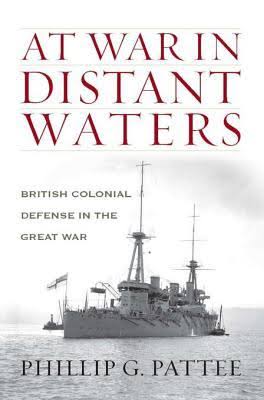
At War in Distant Waters: British Colonial Defense in the Great War. By Phillip G Pattee. Naval Institute Press, Annapolis, 2013.
Reviewed by Tim Coyle
THIS book examines Britain’s maritime and military campaigns beyond Europe in World War One. It posits the argument that, far from being an inconsequential sideshow to the main game in Europe, British strategic planning was directed to an ordered campaign to secure Britain’s shipping and communications lifelines.
Phillip Pattee, a former US Navy submariner and latterly a professor at the US Army Command and general Staff college, critiques the conventional view propounded by several historians, which include the official British maritime war historian Julian Corbett, who assessed the several combined military and naval operations in distant operational areas were minor skirmishes and not acknowledging that it was in reality considered British strategy for the Royal Navy to counter the threat from German commerce raiders and retain command of the seas.
The threat from the Imperial German Navy – Admiral Tirpitz’s ‘Risk Fleet’ – had matured by war’s outbreak in 1914 requiring the RN’s most modern and powerful ships to be concentrated in home waters. Britain owned 50 percent of the world’s shipping fleet as part of a labyrinthine but efficient web of schedules and tramp sailings. Britain also controlled 80 percent of international cable communications. Imports from the vast British Empire and exports to the world were critical to Britain’s survival.
Pattee argues that the British campaign outside of Europe was a global strategy essential to denying Germany access to bases and logistic support for commerce raiders. Britain had a whole-of-government mechanism ranging from diplomatic pressures built up over many years through to an intelligence reporting network coordinated by the Admiralty with reporting officers – mainly shipping agents – in most ports which monitored German shipping movements.
‘At War in Distant Waters’ expands the strategic narrative by profiling the British arrangements for supporting shipping as war risks through industry ‘insurance clubs’ providing government-backed cover to ensure maritime trade could continue against the threat of commerce raiders. British and German foreign policies pre-war and tensions arising are covered in detail as are the world-wide operations and assaults on German colonies and infrastructure. Of note was the Australian Naval and Military Expeditionary Force’s seizure of German colonial ports and high frequency radio stations at Rabaul and Pacific islands and New Zealand’s taking the colony at Samoa. The RAN, in the form of the battlecruiser HMAS AUSTRALIA, was the prime threat to the German East Asiatic Squadron commander, Admiral von Spee, as he fled from China across the Pacific in an abortive attempt to reach Germany.
The narrative covers the deployment quandary faced by the Admiralty in stationing cruisers at strategic locations to protect shipping against the urgent need for cruisers in home waters. However, within two years the German raider threat had been eradicated and the details of these engagements are described in detail. The effectiveness of the campaign against the raiders and the neutralising of German overseas territories was one of the factors influencing Germany to turn to unrestricted submarine warfare in 1916 for which the only antidote was the wholesale adoption of the convoy system.
‘At Sea in Distant Waters’ is a comprehensive treatise of the sophisticated British strategy for assurance of maritime trade in a global war and provides a wide-ranging and innovative narrative of foreign policy, diplomacy and naval strategy far removed from the stalemated horrors of the European land war.
Perhaps the irony for Australia in the urgent search for von Spee’s fleeing squadron was his escape from the RAN’s battlecruiser HMAS AUSTRALIA which may well have destroyed both German armoured cruisers were they to be met at sea in the Pacific. HMAS AUSTRALIA’s fate was to be sent to the North Sea after the German East Asiatic Squadron’s destruction at the Battle of the Falklands. There the mighty ship lost its individuality among the grey steel walls of the Grand Fleet only to quietly return to its homeland in 1919, obsolete and soon to be discarded.



